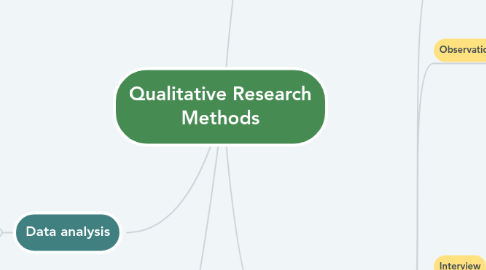
1. Qualitative Data
1.1. Acccounts
1.2. Product of interaction between researcher and participants
2. Data analysis
2.1. Provide underlying meaning
2.2. Interpret raw data
2.3. Transforming raw data by:
2.3.1. Searching
2.3.2. Evaluating
2.3.3. Coding
2.3.4. Recognizing
2.3.4.1. trends
2.3.4.2. themes
2.3.4.3. patterns
2.3.4.4. categories
2.3.5. Mapping
2.3.6. Exploring
2.3.7. Describing
2.4. Types
2.4.1. Content analysis
2.4.2. Narrative analysis
2.4.3. Framework analysis
2.4.4. Thematic analysis
2.5. Analyzing interview
2.5.1. Organizing data
2.5.2. Finding and organizing data
2.5.2.1. Coding and categorizing data
2.5.3. Building over-arching themes in the data
2.5.4. Ensuring Reliability and Validity in the Data Analysis and in the Findings
2.5.4.1. Triangulation
2.5.5. Finding Possible and Plausible Explanations of the Findings
3. Recording Data
3.1. Data recording protocols
3.1.1. Forms designed by researchers to record information
3.1.2. Interview protocol
3.1.2.1. Contains instructions for interviews
3.1.2.2. Development and Design
3.1.2.2.1. Header
3.1.2.2.2. Suggestions
3.1.2.2.3. Purpose of the study
3.1.2.2.4. Reminder from signing the consent form
3.1.3. Observation protocol
3.1.3.1. used for taking field notes
4. Data Collection
4.1. Gathering and measuring information
4.2. Observation
4.2.1. Gathering by observing the research site
4.2.2. Types
4.2.2.1. Complete participant
4.2.2.2. Participant as observer
4.2.2.3. Observer as partcipant
4.2.2.4. Complete observer
4.3. Interview
4.3.1. Gathering data from humans by asking questions verbally
4.3.2. Types
4.3.2.1. One-on-one interview
4.3.2.2. Focus group discussion
4.3.2.3. Telephone interview
4.3.2.4. Electronic e-mail interviews
4.3.2.5. Open-ended questions on questionnaires
4.4. Documents
4.4.1. Public
4.4.1.1. records that qualitative researchers obtain about a site or participants in the study
4.4.2. Private
4.4.3. Newspapers
4.4.4. Minutes of meeting
4.4.5. Newsletters
4.4.6. Journals
4.5. Audiovisual materials
4.5.1. Image
4.5.1.1. researchers collect to understand central phenomenon under study
4.5.2. Sound
